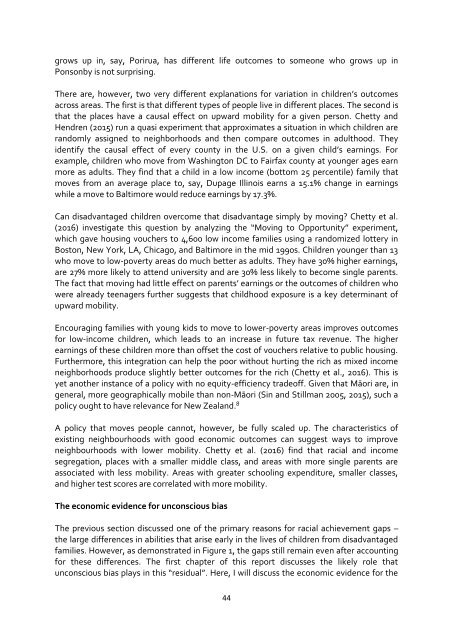UNCONSCIOUS BIAS AND EDUCATION
unconsious-bias-and-education
unconsious-bias-and-education
You also want an ePaper? Increase the reach of your titles
YUMPU automatically turns print PDFs into web optimized ePapers that Google loves.
grows up in, say, Porirua, has different life outcomes to someone who grows up in<br />
Ponsonby is not surprising.<br />
There are, however, two very different explanations for variation in children’s outcomes<br />
across areas. The first is that different types of people live in different places. The second is<br />
that the places have a causal effect on upward mobility for a given person. Chetty and<br />
Hendren (2015) run a quasi experiment that approximates a situation in which children are<br />
randomly assigned to neighborhoods and then compare outcomes in adulthood. They<br />
identify the causal effect of every county in the U.S. on a given child’s earnings. For<br />
example, children who move from Washington DC to Fairfax county at younger ages earn<br />
more as adults. They find that a child in a low income (bottom 25 percentile) family that<br />
moves from an average place to, say, Dupage Illinois earns a 15.1% change in earnings<br />
while a move to Baltimore would reduce earnings by 17.3%.<br />
Can disadvantaged children overcome that disadvantage simply by moving? Chetty et al.<br />
(2016) investigate this question by analyzing the “Moving to Opportunity” experiment,<br />
which gave housing vouchers to 4,600 low income families using a randomized lottery in<br />
Boston, New York, LA, Chicago, and Baltimore in the mid 1990s. Children younger than 13<br />
who move to low-poverty areas do much better as adults. They have 30% higher earnings,<br />
are 27% more likely to attend university and are 30% less likely to become single parents.<br />
The fact that moving had little effect on parents’ earnings or the outcomes of children who<br />
were already teenagers further suggests that childhood exposure is a key determinant of<br />
upward mobility.<br />
Encouraging families with young kids to move to lower-poverty areas improves outcomes<br />
for low-income children, which leads to an increase in future tax revenue. The higher<br />
earnings of these children more than offset the cost of vouchers relative to public housing.<br />
Furthermore, this integration can help the poor without hurting the rich as mixed income<br />
neighborhoods produce slightly better outcomes for the rich (Chetty et al., 2016). This is<br />
yet another instance of a policy with no equity-efficiency tradeoff. Given that Māori are, in<br />
general, more geographically mobile than non-Māori (Sin and Stillman 2005, 2015), such a<br />
policy ought to have relevance for New Zealand. 8<br />
A policy that moves people cannot, however, be fully scaled up. The characteristics of<br />
existing neighbourhoods with good economic outcomes can suggest ways to improve<br />
neighbourhoods with lower mobility. Chetty et al. (2016) find that racial and income<br />
segregation, places with a smaller middle class, and areas with more single parents are<br />
associated with less mobility. Areas with greater schooling expenditure, smaller classes,<br />
and higher test scores are correlated with more mobility.<br />
The economic evidence for unconscious bias<br />
The previous section discussed one of the primary reasons for racial achievement gaps –<br />
the large differences in abilities that arise early in the lives of children from disadvantaged<br />
families. However, as demonstrated in Figure 1, the gaps still remain even after accounting<br />
for these differences. The first chapter of this report discusses the likely role that<br />
unconscious bias plays in this “residual”. Here, I will discuss the economic evidence for the<br />
44


